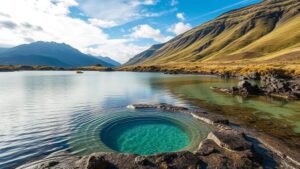Discovering the steaming fumaroles of Bolivia’s Sol de Mañana geothermal field.
Discovering the Steaming Fumaroles of Bolivia’s Sol de Mañana Geothermal Field
Deep within the altiplano of Bolivia, nestled in the stunningly unique landscape of the Eduardo Avaroa Andean Fauna National Reserve, lies the Sol de Mañana geothermal field. This remarkable site showcases a breathtaking array of geothermal features, including steaming fumaroles, colorful hot springs, and bubbling mud pots, all of which provide a window into the Earth’s geothermal activity. Visitors to this alien-like environment are often left in awe of the natural wonders that abound in this high-altitude region.
Geological Significance of Sol de Mañana
The Sol de Mañana geothermal field is situated at an altitude of around 4,850 meters (15,920 feet) and is part of the larger geothermal system associated with the Andean volcanic arc. This region is characterized by its tectonic activity, which creates the conditions for geothermal features to flourish. The fumaroles here emit steam and sulfur gases, serving as a visual display of the geothermal energy lying just beneath the Earth’s surface.
Historical studies have shown that this area is not only active today but has also been an essential part of Bolivian culture and geography for centuries. For example, the geothermal activity has been utilized by local communities for cooking and heating purposes for generations. term Sol de Mañana translates to Morning Sun, reflecting the mesmerizing steam that rises prominently from the ground, often visible in the early hours.
The Fumaroles: Nature’s Steam Engine
Fumaroles are openings in the Earth’s crust that emit steam and gases, particularly in volcanic areas. The fumaroles at Sol de Mañana are especially notable due to their striking appearance and significant geothermal activity. They can reach temperatures of up to 200°C (392°F), with steam jets bursting forth from the ground like natures geysers.
- Interestingly, fumaroles can also emit various gases, including sulfur dioxide and hydrogen sulfide, which give the area a distinct smell. Visitors often remark about the pungent aroma reminiscent of rotten eggs.
- Also, the ground around fumaroles can be sensitive and fragile. Travelers are encouraged to tread carefully to preserve the delicate ecosystems that thrive in such extreme conditions.
Visiting Sol de Mañana: A Travelers Guide
For those wishing to experience the surreal beauty of Sol de Mañana, a typical visit usually occurs as part of a multi-day tour through the Bolivian Altiplano, often starting in Uyuni. The journey usually includes stops at other remarkable sites, such as the vast salt flats of Salar de Uyuni and the vibrant Laguna Colorada.
Here are some practical considerations for visitors:
- Best Time to Visit: The dry season, from May to October, is generally the best time to explore the region. During these months, the weather is cooler and drier, making it easier to navigate the breathtaking landscapes.
- Altitude Awareness: Visitors should be aware that the altitude can lead to altitude sickness. It is advisable to acclimatize and stay hydrated while exploring.
- Photography Tips: Early morning is an excellent time for photography, as the sunlight creates stunning contrasts against the steam and mineral colors.
The Broader Ecological Impact
Geothermal fields like Sol de Mañana play an essential role in understanding the Earth’s geological and ecological processes. They offer insights into sustainable energy sources and help monitor the impacts of climate change. This specific field contributes to Bolivias potential for renewable energy, showing promise for geothermal energy development in the future.
Plus, it’s vital to protect these natural wonders to maintain their integrity for future generations. Conservation efforts in the region focus on balancing tourism with preserving the delicate ecosystems found within the Eduardo Avaroa Andean Fauna National Reserve.
Actionable Takeaways
Visiting the Sol de Mañana geothermal field is not only a chance to witness the steaming fumaroles and diverse geological formations but also an opportunity to engage with Bolivias unique cultural and environmental heritage. Here are some actionable tips for travelers:
- Ensure adequate preparation for altitude by allowing time to acclimatize and carrying medications for altitude sickness if necessary.
- Be respectful of the delicate ecosystems by following designated paths and minimizing your impact on the landscape.
- Consider exploring with guided tours that support local communities and promote sustainable tourism practices.
In summary, the Sol de Mañana geothermal field is a captivating intersection of natural beauty, geological significance, and cultural history. Its steamy fumaroles serve as a reminder of the Earths dynamic processes, attracting adventurers and scientists alike to experience its otherworldly allure.



